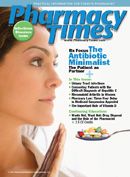Urinary Tract Infections
Pharmacists are in a key position to advise patients with urinary tract infections on the OTC products available, including urinary analgesics and at-home test kits.
Ms. Terrie is a clinical pharmacy writer based in Haymarket, Virginia.

Pharmacists are likely to encounter patients seeking assistance in the selection and proper use of the various OTC products available for providing relief from the pain associated with urinary tract infections (UTIs) and the athome testing kits to detect or confirm the presence of a UTI. OTC products marketed as urinary analgesics contain phenazopyridine hydrochloride, which is an azo dye that exerts a local anesthetic or analgesic effect on the mucosa of the urinary tract (Table).1,2 The precise mechanism of action of phenazopyridine is unknown.1,2

Phenazopyridine hydrochloride is indicated for the symptomatic relief of urinary burning, itching, frequency, and urgency with regard to the symptoms associated with UTIs.1,2 Patients should be reminded that phenazopyridine does not treat a UTI and acts only as an analgesic. Patients should be advised to consult their primary health care provider for further evaluation and treatment.
Common adverse effects associated with phenazopyridine include headache, dizziness, and abdominal cramps. Patients should be advised to take 2 tablets after meals 3 times a day as needed with a full glass of water for no more than 2 days without consulting a physician, and should be reminded to take no more than 12 tablets in a 48-hour period.1-3 These analgesics can be used in conjunction with antibiotics prescribed for the UTI. Patients should be advised to consult their primary care physician if they experience pain or discomfort lasting longer than 2 days.1,2 Phenazopyridine may cause discoloration of the urine to an orange or red color and may also cause staining of clothing.1,2 The use of products containing phenazopyridine should be avoided in those patients with renal disease or those with hypersensitivity to this agent.
Only one OTC product on the market contains the antibacterial agent methenamine and the analgesic sodium salicylate (Table).4 The recommended directions for use of the product are 2 tablets with a full glass of water 4 times a day. This product is not to be used as a replacement for antibiotic therapy.4 Patients with aspirin allergies, a history of gastric ulcers or bleeding disorders, diabetes, gout, or arthritis, or those on anticoagulation therapy, should always consult their primary care physician prior to using this product.4
In addition to analgesic products, nutritional supplement products are available that contain cranberry for preventive therapy. These products assist in maintaining a healthy urinary tract by preventing bacteria from attaching to the bladder wall.5 The exact mechanism of action is unknown, but research suggests that cranberry may inhibit bacteria, particularly Escherichia coli, from adhering to the bladder, kidneys, and urethra.6
OTC Tests for Detecting UTIs
at-home tests are available that detect nitrite; some detect both leukocytes and nitrites. The primary reasons for using UTI test kits are for early detection in individuals with a history of recurring UTIs and to confirm that a UTI has been cured after a complete course of antibiotic therapy.7 Vitamin C doses in excess of 250 mg may result in a false-negative result, because ascorbic acid inhibits the nitrite test reaction.4 Patients should be advised to wait at least 10 hours after ingesting vitamin C before testing.7 Patients should also be informed that if more than 500 mg of vitamin C are ingested within 24 hours of testing, they may obtain a false-negative result for those tests that detect leukocytes.7 Patients on strict vegetarian diets may also get inaccurate results, because the diet provides insufficient urinary nitrates—this, in turn, can cause false-negative nitrite results with UTI tests.7 Tetracycline may also produce a false-negative reading for nitrates.7 Women should be reminded not to use test strips during their menstrual cycle, because blood may cause a false-positive result.7

Conclusion
During counseling, pharmacists should ensure that patients clearly understand that OTC urinary tract analgesics are not intended to treat UTIs, and that they should always consult their primary health care provider for proper treatment. Patients who have never had a UTI or those experiencing severe symptoms also should be referred for further medical evaluation. Those patients susceptible to UTIs may also benefit from various nonpharmacologic measures that may prevent or reduce the incidence of infection. Key preventive measures for women include adequate daily hydration, always voiding when needed, always wiping from front to back after urination to prevent bacteria from entering the urethra, and taking showers instead of baths when possible.8,9
Patients electing to use the urinary tract analgesics should be reminded to adhere to the recommended dosage and duration of use and should be advised of the possible adverse effects that may occur. They should also be encouraged to complete the full course of prescribed therapy. Patients using test kits to detect UTIs should be reminded to immediately consult their primary care provider for medical evaluation and to prevent further complications if they get positive test results, or if they get a negative test result but still experience any urinary discomfort or UTI symptoms. For more in-depth information on UTIs, please visit the National Institutes of Health Web site at http://health.nih.gov/topic/ UrinaryTractInfections. â–
For pharmacist-recommended Urinary Tract Infection Products, visit: http://www.otcguide.net/woman_health.
References
1. Lacy CF, Armstrong LL, Goldman MP, Lance LL. Lexicomp’s Drug Information Handbook. 11th ed. Hudson, Ohio: Lexi comp, Inc; 2003:1093-1094.
2. Monograph - Phenazopyridine Hydrochloride. Medscape Web site. www.medscape.com/druginfo/monograph?cid=med&drugid=150712&drugname=AZO+Standard+Oral&monotype=monograph&secid=2. Accessed December 1, 2009.
3. Uristat Product Information Web site. www.uristat.com/documents/Uristatinsert.pdf. Accessed on December 8, 2009.
4. Cystex Product Information Web site. www.cystex.com/Pages/About%20Cystex. Accessed on December 7, 2009.
5. Azo Cranberry Supplement Product Information Web site.
www.azoproducts.com/faq/azo_cranberry
. Accessed December 2, 2009.
6. McQueen C, Orr K. Natural Products In: Berardi RR, Newton G, McDermott JH, et al, eds. Handbook of Nonprescription Drugs. 16th ed. Washington, DC: American Pharmacists Association; 2009:995.
7. Briggs G, Hurley H. Home Testing and Monitoring Devices. In: Berardi RR, Newton G, McDermott JH, et al, eds. Handbook of Nonprescription Drugs. 16th ed. Washington, DC: American Pharmacists Association; 2009:933-934.
8. Urinary Tract Infections in Adults. National Kidney and Urologic Diseases Information Clearinghouse Web site. http://kidney.niddk.nih.gov/kudiseases/pubs/utiadult/. Accessed November 30, 2009.
9. About Urinary Tract Infections. Azo Product Web site. www.azoproducts.com/uti/about. Accessed on December 4, 2009.

